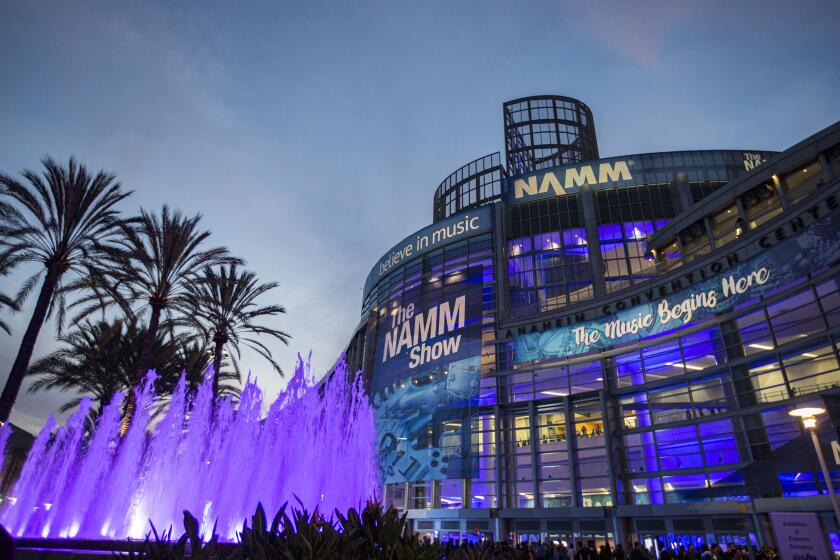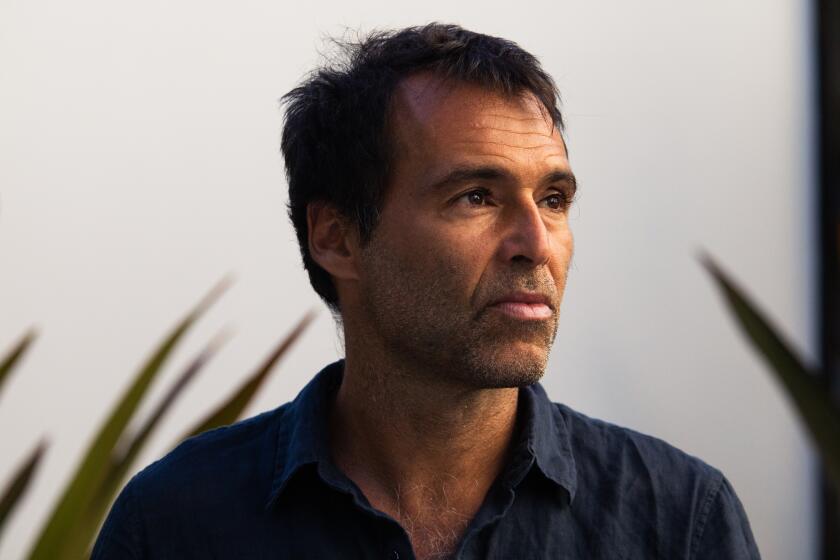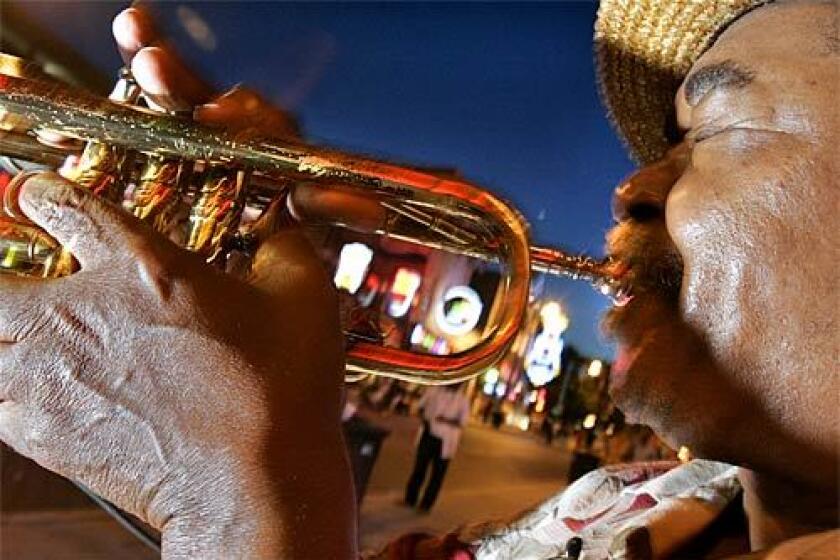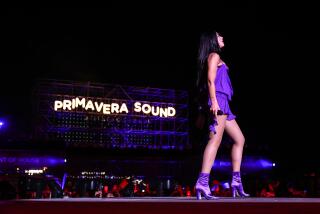Anaheim’s NAMM Show, the huge music instrument and equipment event, pivots post-pandemic
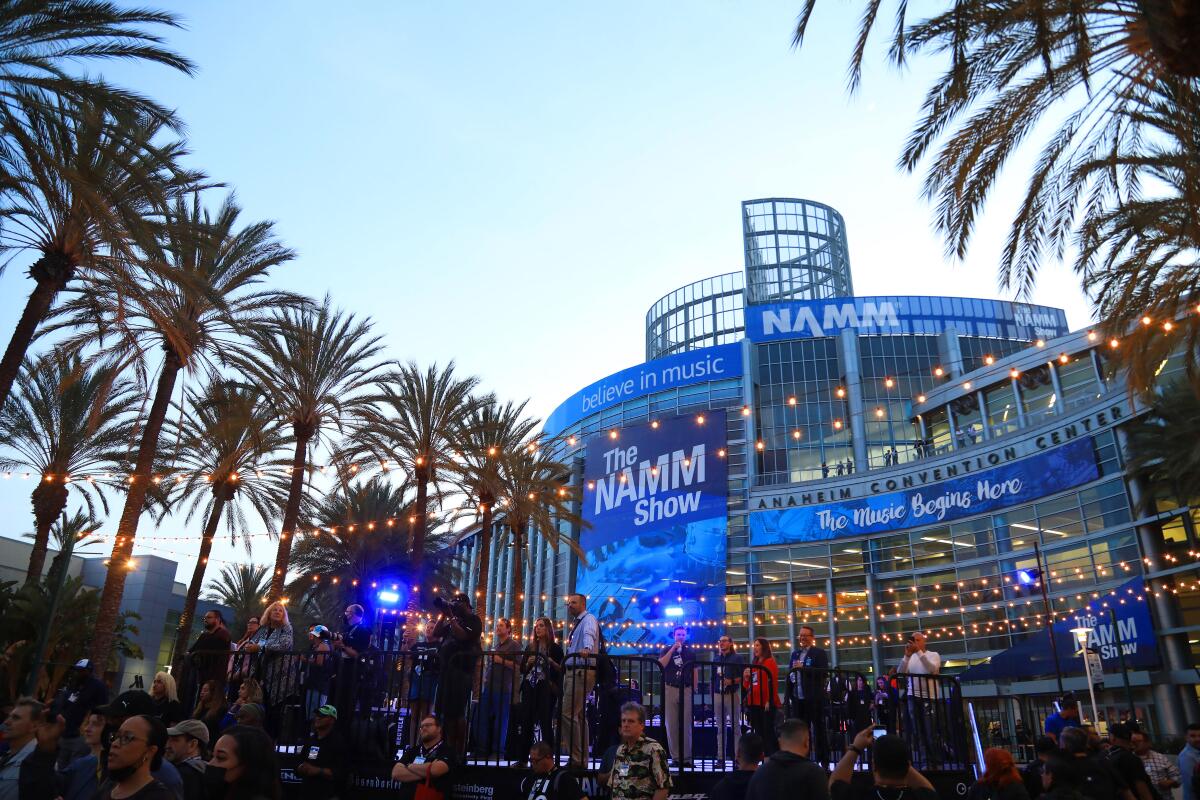
The 2023 NAMM Show, which draws members from more than 120 countries and territories, runs through Sunday
- Share via
For much of its 122-year history, the NAMM Show has served as a vital economic barometer for the creators, manufacturers, distributors and retailers of music instruments and equipment. It has also helped them to navigate unexpected shifts in an industry that saw near-record U.S. sales of $8.7 billion in 2022.
Over the last several years, however, it has been the NAMM Show itself that has navigated unexpected shifts. Long held at the 1.8-million-square-foot Anaheim Convention Center and in adjacent hotel ballrooms, the music industry’s largest annual trade show has changed course several times during the global COVID-19 pandemic.
“We had our biggest NAMM Show ever in 2020, with more than 115,000 NAMM members attending from more than 120 countries and territories. Then COVID hit and our ongoing four-year journey to get back to normal began,” Joe Lamond said. He is the outgoing president of Carlsbad-based NAMM — short for National Assn. of Music Merchants.
As a result of the pandemic, the January 2021 NAMM Show was the first held entirely online. Billed as Believe in Music week, it was also the first NAMM Show that was free and open to the public, rather than only to dues-paying NAMM members.
More changes followed.
The world’s largest and oldest annual musical instrument, equipment and technology show returns to the Anaheim Convention Center this weekend.
As a result of the pandemic’s Delta variant surge, the 2022 NAMM Show was pushed back from January 2022 to last June. It was trimmed from three days to four and reduced its footprint in Anaheim by 50%.
Exhibitors at the 2022 event were spaced farther apart and onsite Rapid Antigen, PCR testing and N95 surgical masks were available to attendees. Color-coded badges allowed every attendee to silently indicate the degree of physical contact they were comfortable having.
Some major exhibitors, including Gibson, one of the world’s largest guitar manufacturers, bowed out of the truncated 2022 NAMM Show.
2023 NAMM Show now underway

Opting to err on the side of caution this year, Lamond and the not-for-profit music trade organization pushed the 2023 NAMM Show back from January to this week. It opens Thursday and runs through Sunday.
“This is another pandemic-scheduled, off-cycle show for us,” said Lamond, who has headed NAMM since 2001.
“This year will be 20% bigger for us than June 2022. But it will by no means be the traditional NAMM Show size. When we get back to January 2024, we’ll be back to normal size.”
Deep inside a cavernous factory in Corona, some legendary rock names gather nonchalantly along a wall.
How challenging have the last several years been?
“Well, I didn’t have gray hair before,” said Lamond, whose original plan to step down after the triumphant 2020 NAMM Show was stymied by the pandemic.
“We’ll have 1,200 exhibitors, up from 1,000 last year, and our registrations to attend this year from members outside the U.S. are up 50%,” Lamond said.
“So, this is the first NAMM Show since before COVID where we will get the music world back together in person. And there are some countries whose NAMM members only see each other in person at the NAMM Show.”
Those members include Daniel Neves. He is president of Brazil Music Assn., which represents about 130 companies. Neves is also publisher of the trade magazine Musica & Mercado.
“The NAMM Show is where the whole industry meets itself,” he said, speaking from his São Paulo office last week.
“It’s funny that I talk in person with more of my Brazilian music industry friends at the NAMM Show than here in Brazil. NAMM leads the industry and gets people inspired and excited. It’s easy to meet everybody at NAMM, and it is much more than a trade show.”
Samba-funk artist Rogê performs at the Hollywood Bowl this weekend: “I’m prouder of being a Brazilian here, because I’m bringing Americans my culture.”
International gathering
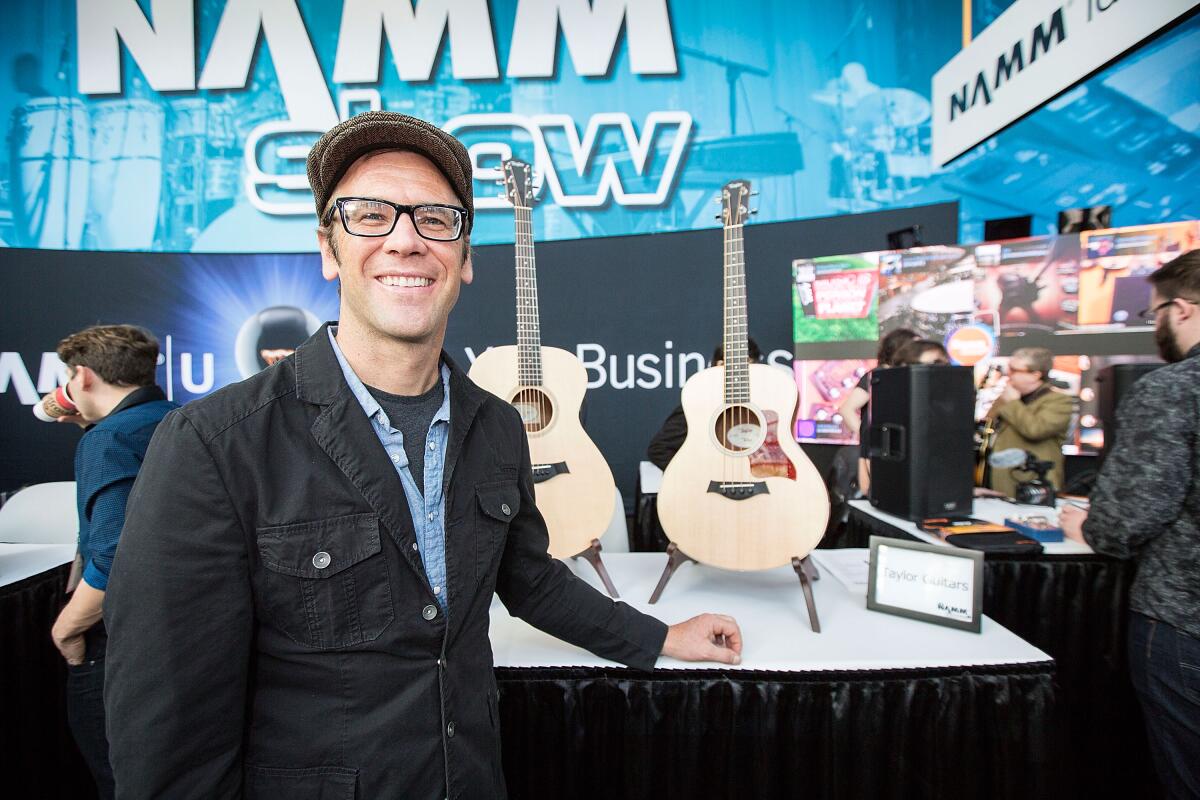
Neves’ sentiments are shared by Yamaha Corp. of America President Tom Sumner.
“The NAMM Show is really the international gathering place for people who make, distribute, sell, service or play musical instruments,” Sumner said.
Yamaha will display some of its latest instruments and music-related products across 15,000 square feet at this year’s NAMM Show. The company will launch 39 new products, more than last year but fewer than at the event’s January 2020 edition. It will also host free outdoor concerts for NAMM attendees throughout the weekend.
“NAMM is the only remaining major trade event for musical instruments and gear in the world,” Sumner said. “There was one in Frankfurt [Germany], the Musikmesse, but it didn’t make it out of the pandemic.”
The NAMM Show has weathered the ups and downs of the last few years as nimbly as possible in such unpredictable circumstances.
From Elvis’ Graceland to the Grand Ole Opry, America’s legends sing a siren song along the historic ‘Music Highway.’
Credit for NAMM’s continuity goes to Lamond for his steady leadership — and to soaring consumer demand for musical instruments, which skyrocketed during the pandemic shutdown. Although the concert touring market suffered huge losses in 2020 and 2021, last year saw the concert industry earn a record gross total of $6.28 billion, according to Pollstar’s Year End Top 200 Worldwide Tours chart.
Guitar sales — which rocketed during the shutdown — dropped a bit last year. But the demand for acoustic and electric keyboards, pro audio equipment and school band and orchestra instruments increased.
The 2022 U.S. sales of $8.7 billion, as reported by 132-year-old magazine the Music Trades, represent a 2.3% drop from 2021. Even so, last year’s sales were second only to 2021’s record $8.8 billion.
“Overall, the industry is bigger now than it was before the pandemic,” Yamaha’s Sumner said. “The pandemic gave people in the U.S. time to take up instruments, while the government stimulus checks made it possible for a lot of folks to buy instruments.
“And Joe Lamond has done a fantastic job guiding us all for the past 23 years and making all the pivots during the pandemic. This will be an emotional NAMM Show.”
Whether you plan to head to Indio for Coachella 2023, or are streaming the festival from home, you may have questions. If so, we got you covered.
Lamond’s successor, John Mlynczak, is the immediate past president of the Technology Institute of Music Educators and was the vice president of music education and technology at Hal Leonard, the world’s largest sheet music publisher.
“I’ll be CEO for one more NAMM Show and be involved with our NAMM education programs for the next three years,” Lamond said. “When I wake up on May 1, I won’t have to go in the office. I’ll probably go on a long motorcycle trip.”
By the numbers
NAMM won’t release its complete 2022 global sales report until later this year. But it did provide some preliminary U.S. figures for 2022.
- Total U.S. music instrument and gear sales totaled $8.7 billion.
- Sales of guitars, both acoustic and electric, saw declines of 4.5% (to $1.04 billion) and 7.7% ($859.1 million), respectively.
- Sales of guitar effect pedals increased 7.6% to $177.5 million and multi-effect processors increased 2.2% to $97.1 million. Unit sales of effects pedals decreased 5.1% to 1.4 million units. Multi-effect processor unit sales declined 6.1% to 185,000 units.
- The entire professional audio market increased 0.5% to $1.48 billion, with all categories reporting increases.
- Keyboard sales, under the $199 price point, increased 11% to $67.1 million. Unit sales increased 3.8% to 621,000.
- Acoustic pianos increased 17.1% to $362.6 million. Unit sales increased 17.1% as well.
- Digital pianos increased 3% to $265 million, while units sold decreased 12.9% to 203,400 units.
- The school music market did extremely well. It saw a jump of 13.5% in retail sales to $739.3 million and 11.7% in units to 800,000.
- Educational percussion sales for school bands and orchestras increased 12.5% to $49.5 million.
More to Read
Inside the business of entertainment
The Wide Shot brings you news, analysis and insights on everything from streaming wars to production — and what it all means for the future.
You may occasionally receive promotional content from the Los Angeles Times.
